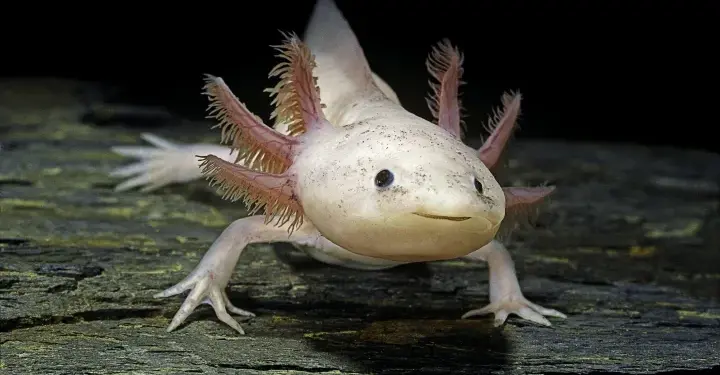Key Takeaway:
- Astonishing Axolotl Facts: Axolotls are fascinating creatures that exhibit unique characteristics. They have the ability to regenerate body parts, including their spinal cord, heart, and eyes. Axolotls also have a remarkable trait of retaining their juvenile features throughout their lifespan, a phenomenon called neoteny.
- Scientific Classification: The axolotl belongs to the animal kingdom, the chordate phylum, the vertebrate class, and the amphibian order. Its scientific name is Ambystoma mexicanum.
- Habitat and Behavior: Axolotls are native to the Xochimilco and Chalco regions of Mexico. They primarily inhabit freshwater lakes and canals. These amphibians are nocturnal and are skilled swimmers. They also display unique feeding behavior, using suction to draw in their prey.
- Conservation Status and Threats: The axolotl is critically endangered in its natural habitat due to habitat destruction, pollution, invasive species, and overexploitation for the pet trade. Conservation efforts are in place to protect and restore axolotl populations.
Introduction
The Axolotl: A Fascinating Creature with Incredible Abilities
Native to Mexico, the Axolotl, also known as the Mexican Walking Fish, is an extraordinary amphibian that possesses astonishing regenerative capabilities. This unique creature is a critically endangered species that holds great significance for scientific research due to its ability to regrow its limbs, spinal cord, heart, and even parts of its brain. Studying the Axolotl’s remarkable regenerative process could provide valuable insights for medical advancements and regenerative therapies.
Axolotls are not only known for their regenerative abilities, but also for their unusual appearance. With their external gills, fluffy skin, and permanently juvenile features, they exhibit a distinct aesthetic appeal that captures the interest of both scientists and enthusiasts alike. These captivating creatures have captivated the hearts of many and have become popular as pets, contributing to conservation efforts and raising awareness about their endangered status.
Moreover, the Axolotl’s natural habitat plays a crucial role in their survival. These semiaquatic creatures primarily inhabit freshwater bodies such as lakes, canals, and ponds, primarily in Mexico City. However, due to urban development and water pollution, their natural habitat has been significantly disrupted, posing a serious threat to their population. Conservation efforts and strict regulations are essential to protect these unique creatures and ensure their long-term survival.
True Fact: The Axolotl possesses the extraordinary ability to regenerate not only its limbs but also its vital organs, such as its heart and brain. (Source: Astonishing Axolotl)
Astonishing Axolotl Facts
The Astonishing Axolotl Facts are fascinating and extraordinary features about the Mexican Walking Fish. Discover three key points about these amazing creatures: their ability to regenerate body parts, their unique appearance with external gills, and their ability to stay in a juvenile aquatic state. In addition, learn about other extraordinary details that make axolotls truly remarkable. To care for axolotls, it is recommended to provide appropriate tank conditions, feed them a balanced diet, and ensure proper water quality. These suggestions help maintain their well-being and promote their natural behaviors.
| Fact | Description |
|---|---|
| Species | Ambystoma mexicanum |
| Origin | Mexico |
| Habitat | Freshwater lakes and canals |
| Unique Feature | Ability to regenerate limbs and organs |
| Lifespan | 10-15 years in captivity |
| Size | Up to 12 inches (30 cm) in length |
| Diet | Carnivorous, primarily eat small aquatic creatures |
| Conservation Status | Critically endangered |
Axolotl Scientific Classification
The scientific classification of the Axolotl, also known as the Mexican Walking Fish, provides important information about its taxonomic categorization. Here is a table showcasing the classification:
| Kingdom | Animalia |
|---|---|
| Phylum | Chordata |
| Class | Amphibia |
| Order | Urodela |
| Family | Ambystomatidae |
| Genus | Ambystoma |
| Species | Ambystoma mexicanum |
Axolotl Physical Characteristics
| Characteristic | Description |
|---|---|
| External Gills | Axolotls have feathery external gills that extend from the sides of their heads, which they use for respiration. |
| Limb Regeneration | One of their most unique features is the ability to regenerate lost limbs, including legs, tails, and even parts of their spinal cord. |
| Smooth, Slimy Skin | They have smooth, slimy skin with a variety of colors, including shades of pink, gray, brown, and albino. |
| No Eyelids | They lack eyelids, so their eyes remain open at all times. |
| Tufted Crests | Some axolotls have tufted crests along their backs, giving them a unique appearance. |
| Toothless | They are toothless, using suction to catch their prey. |
Notably, the Axolotl belongs to the Animalia kingdom, Chordata phylum, Amphibia class, Urodela order, Ambystomatidae family, Ambystoma genus, and the Ambystoma mexicanum species. Fascinatingly, the Axolotl’s taxonomic classification highlights its unique characteristics and evolutionary lineage.
To fully grasp the Axolotl’s scientific classification, it is essential to understand its distinct features, such as its ability to regenerate body parts and its neoteny, which allows it to retain its juvenile form throughout its lifespan. These unique details contribute to its scientific classification and distinguish it from other amphibians.
Discover more about the Axolotl’s scientific classification and marvel at its extraordinary nature. Don’t miss out on exploring this fascinating creature’s taxonomic categorization and uncovering the wonders of its evolutionary journey.
Habitat and Behavior
The Astonishing Axolotl is known for its fascinating characteristics and its natural environment. This aquatic creature dwells primarily in freshwater habitats, such as lakes and ponds, in Mexico. It exhibits a unique behavior of neoteny, retaining its juvenile features throughout its life. Axolotls are distinguished by their ability to regenerate body parts, making them remarkable creatures. Additionally, these amphibians have a nocturnal lifestyle, preferring to be active during the night. Axolotls are also known for their docile nature, making them popular pets among enthusiasts. Care should be taken to ensure their habitat is clean and suitable, with enough hiding spots and proper water quality. By providing a suitable environment, including optimal water temperature and a balanced diet, the natural behaviors and habitat of axolotls can be maintained, leading to their overall well-being. Axolotls colors, which can vary widely depending on their age, genetics, and environmental factors.
Conservation Status and Threats
Axolotl Conservation: Status and Dangers
The conservation status and threats facing the axolotl warrant serious attention. This remarkable creature, also known as the Mexican walking fish, faces numerous challenges that affect its survival in the wild.
One of the primary threats to the axolotl is habitat destruction. The degradation and loss of its natural habitat, especially the canals and marshes of Mexico City, have significantly impacted the axolotl population. Additionally, water pollution caused by urbanization and agricultural activities poses a grave danger to these amphibians.
Another major concern is the introduction of invasive species, such as tilapia and carp, which compete with axolotls for resources and prey on their eggs and larvae. This further exacerbates the already critical situation for the axolotl.
Moreover, the illegal pet trade also contributes to the decline of axolotl populations in the wild. The demand for these unique creatures as exotic pets has led to the unsustainable collection of axolotls from their natural habitat.
To protect the axolotl and prevent its extinction, various conservation efforts have been initiated. These include the establishment of protected areas, breeding programs in captivity, and educational campaigns to raise awareness about the importance of preserving this species and its habitat.
Understanding the historical significance of these efforts highlights the urgency in addressing the conservation status and threats faced by the axolotl. The survival of this incredible amphibian depends on our collective actions to protect its habitat, regulate the pet trade, and control invasive species. Only through these measures can we ensure a brighter future for the axolotl.
Learn about more animals with the pages below:
Animals that start with A
Animals that start with B
Which Animal Has The Shortest Life Span ?
Conclusion
The astonishing Axolotl, also known as the Mexican Walking Fish, is a unique creature with fascinating characteristics.
It is an amphibian that retains its juvenile form throughout its life, known as neoteny.
This allows it to keep its gills and live solely in freshwater.
The Axolotl’s ability to regenerate its own body parts, including the heart, spinal cord, and even parts of its brain, is truly remarkable.
This feature makes it a subject of study for scientists researching tissue regeneration.
The Axolotl’s popularity as a pet has increased due to its unusual appearance and intriguing biology.
To fully appreciate this incredible creature, more research and conservation efforts are needed.
Don’t miss the chance to learn more about the astonishing Axolotl and contribute to its preservation.
Axolotl Facts | Astonishing Axolotl (Mexican Walking Fish)
- ✅ Axolotls can regenerate their limbs, spines, brains, and nearly every other body part.
- ✅ They exhibit a trait called neoteny, which means they never outgrow their juvenile characteristics like other salamanders.
- ✅ Axolotls are commonly called “Mexican walking fish” even though they are not fish at all.
- ✅ Their habitat is high altitude freshwater lakes and they are found only in one complex of lakes.
- ✅ Axolotls are carnivores and their main prey includes worms, insects, and molluscs.
FAQs About Axolotl Facts | Astonishing Axolotl (Mexican Walking Fish)
What is the scientific name of the axolotl?
The scientific name of the axolotl is Ambystoma mexicanum.
What is the classification of the axolotl?
The axolotl belongs to the Kingdom Animalia, Phylum Chordata, Class Amphibia, Order Caudata, Family Ambystomatidae, and Genus Ambystoma.
Where can axolotls be found?
Axolotls can only be found in one complex of lakes in the Valley of Mexico, particularly in the Lake Xochimilco region.
How many babies do Axolotls have?
The average number of babies an Axolotl has is 500.
What is an interesting fact about Axolotls?
Axolotls are found only in one complex of lakes!
What is the main prey of axolotls?
Axolotls primarily feed on worms, insects, and molluscs.
How long can an Axolotl live?
Axolotls have a lifespan of 10 to 15 years in captivity when provided with proper care, including clean water, a suitable diet, and an appropriate habitat.
Are Axolotls aggressive?
No, Axolotls are not aggressive. They are generally docile and peaceful creatures. They are more likely to be shy and prefer to avoid confrontation with other animals, including their own kind.
What is the distinctive feature of axolotls?
Axolotls have feathery gills and a flattened-shaped head, which are distinctive characteristics of this species.
Why are axolotls considered the rarest species of salamander?
Axolotls are considered the rarest species of salamander because they are only found in one complex of lakes and their population in the wild is critically endangered, on the brink of extinction.
How to Say “Axolotl” in different languages:-
- Spanish: “Axolote” (pronounced ah-soh-LOH-teh)
- French:“Axolotl” (pronounced ahk-soh-LOH-tuhl)
- German: “Axolotl” (pronounced ahk-soh-LOH-tel)
- Italian: “Axolotl” (pronounced ahk-soh-LOH-tl)
- Portuguese: “Axolote” (pronounced ah-soh-LOH-teh)
- Dutch: “Axolotl” (pronounced ahk-soh-LOH-tl)
- Russian: “Аксолотль” (pronounced ahk-soh-LOHTL)
- Chinese (Simplified): “墨西哥瘦西湖蝾螈” (pronounced Mòxīgē shòuxīhú róuyuán)
- Japanese: “アホロートル” (pronounced Ahorōtoru)
- Korean: “아솔로틀” (pronounced Asollothl)
- Arabic: “أكسولوتل” (pronounced Aksolotl)
- Hindi: “एक्सोलोटल” (pronounced Ekso-lo-tl)
- Swahili: “Axolotl” (pronounced ahk-soh-LOH-tl)
- Turkish: “Akso-lotl” (pronounced Ahk-so-lo-tl)
- Greek: “Αξολότλ” (pronounced Aksolotl)









